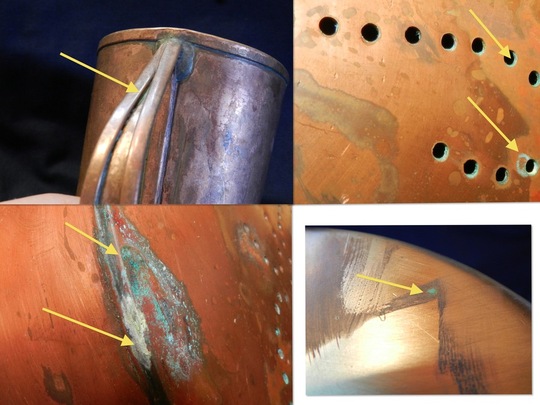About Brass and Copper Cookware

Caring for and Cleaning Your Cookware
A Little Backround
Two hundred years ago, a copper tea or coffee pot cost a working man a months' wages. Because they were expensive, they were kept clean and cared for. If cooking over a fire, a light coat of soap on the bottom and sides helped in soot removal (suggested by an Elizabethan cook book).
The originals we copy have survived for any one of many reasons. One thing is certain, they were taken care of. A copper piece was, and is, a pricey item. You would keep it clean both inside and outside to the best of your ability. Proof? The best sand for cleaning pots was imported from France! If people took the trouble to import sand from France to clean with, they really cared about their cookware! This also explains why so much early domestic cookware has exposed edges that are polished smooth. They did not start out that way! The mark of a good housekeeper was that her copperware was penny-bright.
We make all our pieces with period metal weight and joining styles. Used properly, they should last 200 years ... the originals did!
Caring for Tin-Lined Cookware
All of our cookware is real. They are made to be used on a hearth or a modern stove top.
Only wooden utensils should be used on tin lined cookware. Metal utensils will scratch and wear through the tin lining. Use wood, horn, or (perish the thought!) plastic utensils.
The first rule for using tin lined cookware is "Never boil the pot dry"! The second rule is "Everyone eventually boils a pot dry"! Tin lining will melt if there is no liquid in the pot to keep the temperature below the tin's melting point. All tin will melt at 425 degrees - that means no sautéed onions, no modern-style oatmeal, no rice - these should all be cooked in earthenware. 18th century style oatmeal (very soupy and watery) may be cooked at low temperatues (under 425 degrees) in tin-lined copper items. There must always be liquid on our cookware whenever they are over a heat source.
If you do boil your pot dry and make tin-lined oatmeal for breakfast, it's not the end of the world. Your pot, kettle or pan is still food safe, as long as you keep the bare metal free from verdigris. I wouldn't eat the tin-lined oatmeal, though.
Cleaning Your Cookware
To keep the copper or brass shinning, use "Wright's Copper Cream". These products make shining copper & brass easy. But remember, it is okay to let your cookware turn a warm brown (copper), or deep red-brown (brass).
Scrub the OUTSIDE ONLY (never scrub tin lining) of your cookware with a Scotch Brite pad, a Brillo pad, or a sponge. Always make sure the piece is thoroughly dry before storing it.
The inside of your tin-lined cookware should be cleaned with a soft sponge or cloth. DO NOT clean the tin lining with an abrasive product - this will wear the tin lining off. Unfortunately, we do not offer re-tinning services any longer.
Colors of Copper and Brass Cookware
Bare Metal: Copper and Brass
Your copper or brass item will arrive to you with a bright bare finish – we do not coat our cookware with anything other than a little mineral oil. Bare finishes are safe to eat from and cook with.
After a while copper and brass will develop a patina. Copper will turn a warm brown or red (the color of an old penny), and brass will turn a reddish color. This patina is food safe, but can be removed if you like. Scrub your copper or brass with a Scotch Brite pad or Brillo, and warm water. Thoroughly dry the piece – if it remains wet, the tarnish will return quickly.
Below: bare copper with two types of patina on the left, and bare brass with two types of patina on the right.

When Your Cookware Turns Green
If left wet or dirty for a while, copper and brass will develop bright green-blue to grey discolorations known as verdigris. Verdigris is what gives the Statue of Liberty its greyish-green color. Verdigris is poisonous. If your copper or brass cookware shows any signs of verdigris, it is not food safe until it is cleaned. Once all the verdigris is scrubbed off, your cookware is food safe again.
Verdigris develops in the cracks where moisture collects or drips off of a piece of cookware. Check underneath the wire rims and the folds of the metal for verdigris. Always make sure your cookware is thoroughly dried before storing it.
Below are three images of verdigris developing on copper, and on the bottom right, verdigris on brass.


Above, extremely heavy verdigris and rust on the inside of a 1630-50 kettle dug in New York. What your cookware really, really should not look like, unless it's been buried for over 200 years and there's no way food is ever touching it again!
Tin Lining
The tin we use for lining our cookware is food-grade tin and will not rust. Your tin-lined items will arrive with a bright silver finish. Tin linings will eventually turn black after use. This is normal and is completely food safe.
Below, tin lining as it will look on our products when new.


And finally, a little demonstration of cooking heat.
A picture is worth a thousand words ... the standing bit of solder on the left was in an oven at 350 degrees, while the one on the right was in a 400 degree oven. That's why you don't want to exceed 350 degrees with anything tin lined or soldered.
Back to Top
Click Here To Email Goose Bay Workshops LLC
|






